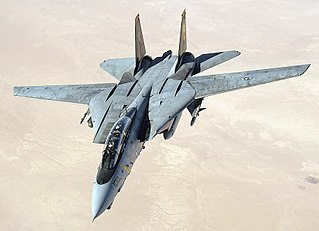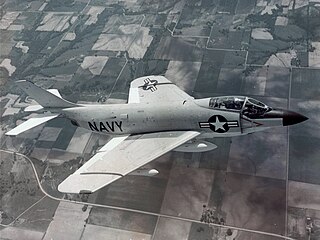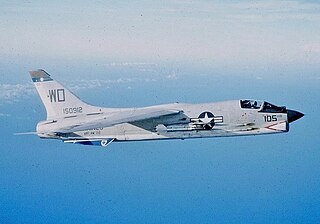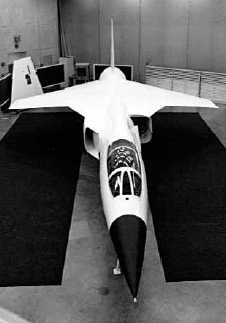Related Research Articles

The Grumman F-14 Tomcat is an American carrier-capable supersonic, twin-engine, two-seat, twin-tail, all-weather-capable variable-sweep wing fighter aircraft. The Tomcat was developed for the United States Navy's Naval Fighter Experimental (VFX) program after the collapse of the General Dynamics-Grumman F-111B project. A large and well-equipped fighter, the F-14 was the first of the American Teen Series fighters, which were designed incorporating air combat experience against MiG fighters during the Vietnam War.

The McDonnell F3H Demon is a subsonic swept-wing carrier-based jet fighter aircraft designed and produced by the American manufacturer McDonnell Aircraft Corporation. It was the first swept wing jet fighter and the only single-engined carrier-based fighter the company produced.

The Vought F-8 Crusader is a single-engine, supersonic, carrier-based air superiority jet aircraft designed and produced by the American aircraft manufacturer Vought. It was the last American fighter that had guns as the primary weapon, earning it the title "The Last of the Gunfighters".

The Grumman F11F/F-11 Tiger is a supersonic, single-seat carrier-based fighter aircraft designed and produced by the American aircraft manufacturer Grumman. For a time, it held the world altitude record of 76,939 feet (23,451 m), as well as being the first supersonic fighter to be produced by Grumman.

The North American FJ-2 and FJ-3 Fury are a series of swept-wing and carrier-capable fighters for the United States Navy and Marine Corps. The FJ-2 resulted from an effort to navalize the North American F-86 Sabre operated by the United States Air Force. These aircraft feature folding wings, and a longer nose landing strut designed to increase angle of attack upon launch and to accommodate a longer oleo to absorb the shock of hard landings on an aircraft carrier deck.

The Douglas F5D Skylancer is a development of the F4D Skyray jet fighter for the United States Navy. Starting out as the F4D-2N, an all-weather version of the Skyray, the design was soon modified to take full advantage of the extra thrust of the Pratt & Whitney J57 eventually fitted to the Skyray instead of the Westinghouse J40 originally planned.

The North American XF-108 Rapier was a proposed long-range, high-speed interceptor aircraft designed by North American Aviation intended to defend the United States from supersonic Soviet strategic bombers. The aircraft would have cruised at speeds around Mach 3 with an unrefueled combat radius over 1,000 nautical miles, and was equipped with radar and missiles offering engagement ranges up to 100 miles (160 km) against bomber-sized targets.

The Douglas F6D Missileer was a proposed carrier-based fleet defense fighter designed by Douglas Aircraft Company in response to a 1959 United States Navy requirement. It was designed to be able to loiter for extended periods at a relatively long distance from the Navy's aircraft carriers, engaging hostile aircraft 100 miles (160 km) away with its powerful radar and long-range missiles. Since the enemy would be fired on long before they reached visual range, the aircraft had little dogfighting capability and was strictly subsonic. When doubts were expressed about the Missileer's ability to defend itself after firing its missiles, the value of the project was questioned, leading to its cancellation. Some of the Missileer's systems, primarily the engines, radar, and missiles, continued development in spite of the cancellation, eventually emerging on the ill-fated General Dynamics–Grumman F-111B and successful Grumman F-14 Tomcat years later.

The Dassault Mirage G, also known as the Mirage IIIG, was a variant of the French Dassault Mirage series of supersonic warplanes, but with a variable-sweep wing. Three prototypes were flown; one single-engined G and two twin-engined G8 examples. Various roles, equipment fits and other variants were proposed, but none entered production.

The Lockheed CL-1200 Lancer was a late 1960s company-funded proposal for a fighter aircraft based on the Lockheed F-104 Starfighter. The CL-1200 was conceived and marketed mainly for and to non-US military services, as an export product. As such it would have competed with combat-proven designs like the Dassault Mirage III, McDonnell Douglas F-4 Phantom II, Mikoyan-Gurevich MiG-21, and Northrop F-5E Tiger II. The CL-1200 competed unsuccessfully against proposed fourth generation designs, under the US government's Lightweight Fighter program, which would eventually result in the General Dynamics F-16 and Northrop F-17 Cobra.

The Rockwell XFV-12 was a prototype supersonic United States Navy fighter which was built in 1977. The XFV-12 design attempted to combine the Mach 2 speed and AIM-7 Sparrow armament of the McDonnell Douglas F-4 Phantom II in a VTOL fighter for the small Sea Control Ship which was under study at the time. On paper, it looked superior to the subsonic Hawker Siddeley Harrier attack fighter. However, it was unable to demonstrate an untethered vertical takeoff and its inability to meet performance requirements resulted in the program's termination.

Operational Requirement F.155 was a specification issued by the British Ministry of Supply on 15 January 1955 for an interceptor aircraft to defend the United Kingdom from Soviet high-flying nuclear-armed supersonic bombers.

The Vought XF8U-3 Crusader III was an aircraft developed by Chance Vought as a successor to the successful Vought F-8 Crusader program and as a competitor to the McDonnell Douglas F-4 Phantom II. Though based in spirit on the F8U-1 and F8U-2, and sharing the older aircraft's designation in the old Navy system, the two aircraft shared few parts.

The Vickers Type 559 was a supersonic interceptor aircraft design by the British aircraft company Vickers-Armstrongs and was their submission for Operational Requirement F.155 in 1955.

The Aeritalia F-104S Starfighter was a licensed production Italian version of the Lockheed F-104 Starfighter, which served in the Italian Air Force, and was its mainstay from the late 1960s until the beginning of the 21st century. The F-104S also served in the Turkish Air Force until the mid-1990s. The F-104S was the final development of the Starfighter line.

The General Dynamics–Grumman F-111B was a long-range carrier-based interceptor aircraft planned as a follow-on to the McDonnell Douglas F-4 Phantom II for the United States Navy (USN).

The Vought/General Dynamics Model 1600 series was a fighter aircraft proposal for the United States Navy's Navy Air Combat Fighter (NACF) program. The Model 1600 was a carrier-based derivative of the General Dynamics F-16 Fighting Falcon, but lost to the Northrop/McDonnell Douglas F/A-18 Hornet.

The Grumman F11F-1F Super Tiger is a single-seat fighter aircraft originally developed for the United States Navy (USN). Based on the USN's F-11 Tiger, the F11F-1F did not proceed beyond the two F11F-1F prototypes.

The British Aerospace (BAe) P.1216 was a planned Advanced Short Take Off/Vertical Landing (ASTOVL) supersonic aircraft from the 1980s. It was designed by the former Hawker design team at Kingston upon Thames, Surrey, England that created the Harrier family of aircraft.
References
Notes
Bibliography
- The Illustrated Encyclopedia of Aircraft. London: Aerospace Publishing.[ full citation needed ] (Magazine)
- Angelucci, Enzo (1987). The American Fighter from 1917 to the Present. New York: Orion Books.
- World Aircraft Information Files. London: Bright Star Publishing.[ full citation needed ] (Magazine)
- Buttler, Tony (2008) [First published in 2007]. American Secret Projects: Fighters & Interceptors 1945-1978. Hinckley, England, UK: Midland Publishing. ISBN 978-1-85780-264-1.
- Pelletier, Alain J. (May–June 2000). "Grumman That Never Was: The XF12F—A Tomcat That Never Was". Air Enthusiast . No. 87. pp. 10–11. ISSN 0143-5450.
- Taylor, Michael J. H. (1989). Jane's Encyclopedia of Aviation. London: Studio Editions.